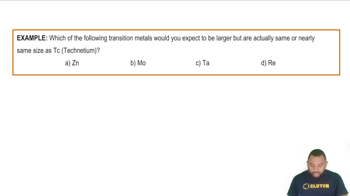Arrange the following atoms in order of increasing effective nuclear charge experienced by the electrons in the 𝑛=3 electron shell: K, Mg, P, Rh, Ti.
Tungsten has the highest melting point of any metal in the periodic table: 3422°C. The distance between the centers of W atoms in tungsten metal is 2.74 Å. a. What is the atomic radius of a tungsten atom in this environment? (This radius is called the metallic radius.)
 Verified step by step guidance
Verified step by step guidance
Verified Solution
Key Concepts
Metallic Radius

Interatomic Distance

Periodic Trends

With the exception of helium, the noble gases condense to form solids when they are cooled sufficiently. At temperatures below 83 K, argon forms a close-packed solid whose structure is shown below. (b) Is this value larger or smaller than the bonding atomic radius estimated for argon in Figure 7.7?
With the exception of helium, the noble gases condense to form solids when they are cooled sufficiently. At temperatures below 83 K, argon forms a close-packed solid whose structure is shown below. (c) Based on this comparison would you say that the atoms are held together by chemical bonds in solid argon?
Tungsten has the highest melting point of any metal in the periodic table: 3422°C. The distance between the centers of W atoms in tungsten metal is 2.74 Å. c. If you put tungsten metal under high pressure, predict what would happen to the distance between W atoms.
Which of the following statements about the bonding atomic radii in Figure 7.7 is incorrect? (i) For a given period, the radii of the representative elements generally decrease from left to right across a period. (ii) The radii of the representative elements for the n = 3 period are all larger than those of the corresponding elements in the n = 2 period. (iii) For most of the representative elements, the change in radius from the n = 2 to the n = 3 period is greater than the change in radius from n = 3 to n = 4. (iv) The radii of the transition elements generally increase moving from left to right within a period. (v) The large radii of the Group 1 elements are due to their relatively small effective nuclear charges.
Estimate the As¬I bond length from the data in Figure 7.7 and compare your value to the experimental As ¬I bond length in arsenic triiodide, AsI3, 2.55 Å.
